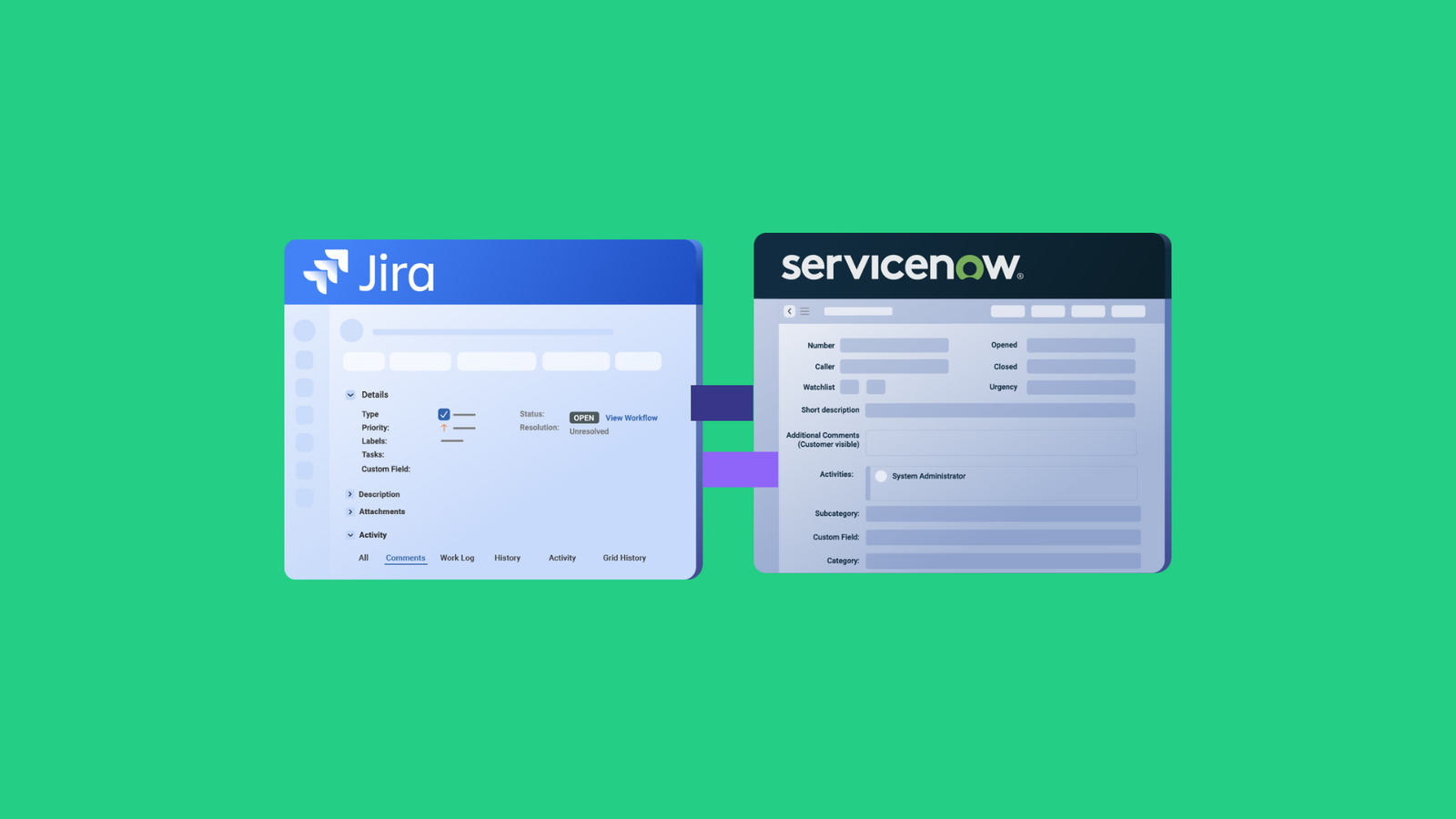The only way for ServiceNow to interact and exchange data with other systems or instances is through a ServiceNow connector.
This connector could be a script, native solution, or third-party integration that sends requests, receives responses, and transforms the data to the correct format.
Organizations can use these ServiceNow connectors internally between teams and externally with clients and service providers.
In this article, I’ll discuss everything worth knowing about ServiceNow connectors as well as why you need them in your stack.
What is a ServiceNow Connector?
A ServiceNow connector (integration) is a solution that enables ServiceNow to interact and exchange data with other applications, databases, cloud services, etc.
With a ServiceNow connector, companies can connect internal applications with ServiceNow or sync data with external entities such as managed service providers (MSPs), clients, and suppliers.
How Do ServiceNow Connectors Work?
The core working principle of ServiceNow connectors hinges on the interaction between APIs. The ServiceNow platform relies on REST (Representational State Transfer) or SOAP (Simple Object Access Protocol) APIs.
So how do these APIs store, fetch, send, and transform data?
For APIs to interact, you need scripts or web services to connect their endpoints.
Scripts refer to code on the server or client-side that controls how the API works. To make changes to ServiceNow scripts, you must know the JavaScript syntax.
Web services could be inbound or outbound. Inbound web services give you access to ServiceNow data via a client application. You can access inbound web services via the GraphQL API framework, SOAP, JSONv2, RSS, and Scripted SOAP web services.
Outbound web services make it possible to send SOAP and REST messages to external systems using the SOAP or REST web service.
The Working Principle of a ServiceNow Connector
So let’s assume you want to connect two ServiceNow instances to share data between two incidents. Here is what happens under the hood.
- The local system authenticates the user using API keys, OAuth, and other credentials.
- The local system sends the request through an endpoint to retrieve data from the remote incident.
- Based on the mapping and configuration, the payload is retrieved and parsed through transformers.
- The transformers convert the payload to the required format (not necessary for ServiceNow to ServiceNow connections).
- If triggers are active, they can fire the response in reaction to an event.
- The remote incident is replicated on the local system based on data retrieved from the API headers.
- If a network error occurs and blocks the queue, the system retries the process automatically.
- If the mapping fails due to an error, the system admin can debug the connection in order to make changes to mappings, scripts, or naming conventions.
The standard workflow is extract, transform, load (ETL) or extract, load, transform (ELT). This can happen in real-time or at regular intervals through batch processing.
Types of ServiceNow Connectors
Any solution that can connect a ServiceNow platform with another system is a connector. But to narrow down the classification, I’ve grouped them into the following categories:
- Native connectors: These solutions are native to the ServiceNow platform. IntegrationHub is the primary connector that natively integrates with ServiceNow. With IntegrationHub Spokes, you can connect with several external applications and services.
- Custom connectors: These are in-house REST/SOAP API integrations created for a specific integration scenario with a ServiceNow organization. Custom scripts control how these systems work.
- Third-party solutions: These are external applications that act as bridge ServiceNow with other systems. They could be ETL tools, ERP/CRM integrations, or middleware connectors.
If the connection is between the ServiceNow instances of deeply embedded companies, eBonding is the recommended solution via REST messages and business rules.
Benefits of ServiceNow Connectors
As a team, subdivision, or organization, here are the benefits of ServiceNow connectors.
Increase Productivity
Automated connectors reduce redundant administrative tasks, decreasing team members’ workload and freeing up time to focus on pressing business issues.
In addition, connecting ServiceNow with other systems reduces the time needed to manually move data between systems and unnecessary context switching between platforms.
Extend System Functionality
ServiceNow connectors extend the capability of your instance by allowing you to connect to CRMs, ERPs, SaaS applications, and databases.
These connectors allow data exchange between default incident fields (attachments, descriptions, comments, etc.) and custom fields.
For instance, you can connect your ServiceNow platform with Slack for instant updates and smooth communication. This also applies to connecting ServiceNow to Salesforce to merge account details with customer-generated incidents.
A cybersecurity MSSP used a Jira connector for ServiceNow for deep ticket integration to bridge their communication gap with customers.
Scale Operations Easily
Since ServiceNow connectors extend functionality, it makes it easier for businesses to onboard new clients without having to overhaul their systems to accommodate them. So as workloads and requests increase, the system will continue to accommodate them.
The scalability and flexibility of your system will be pushed to the limit when something breaks, and the system is flooded with tickets. Only a reliable connector will help your ServiceNow sail through these rough waters.
Migrate Data Between Organizations
Companies can use ServiceNow connectors during mergers and acquisitions to unify processes and databases without disrupting regular operating procedures.
When legacy systems are involved, you can connect them to your ServiceNow instance to ensure uninterrupted data flow.
Apart from mergers and acquisitions, ServiceNow connectors can help companies working together on a common initiative collaborate seamlessly.
Make Informed Decisions
With access to multiple data sources, organizations can get a better view and understanding of customer concerns. Stakeholders can analyze this data to make informed decisions about their business operations or customer relationships.
For instance, if a bug in Jira is linked to multiple security incidents on ServiceNow, then you need to conduct root-cause analysis right away to fix the bug.
Improve Customer Experience
As the IT service management system, ServiceNow connectors help you keep a bead on customer experience. So if the incident resolution time and satisfaction score are down, then you need to improve the services you offer.
Also, access to better data will help you improve service delivery and self-service capabilities without overwhelming your employees. The better the service, the happier the staff.
Reduce Costs
ServiceNow connection tools can help your business save money by reducing what you pay in licensing fees.
How so? Well, let’s assume you want to onboard a client who uses Jira Service Management for ITSM exclusively.
The only way to get your ServiceNow to share data with their Jira instance without paying subscription fees is through platform integration. So, you can retrieve relevant data from their Jira when needed.
How to Use Exalate’s ServiceNow Connector
Exalate is a bidirectional integration tool that allows you to connect ServiceNow with platforms such as Jira, Salesforce, Zendesk, Azure DevOps, and GitHub.
To use Exalate’s ServiceNow connector, here are the steps to follow:
- Install Exalate on your instance (Instance A) by visiting the integrations page.
- The other party should also have Exalate installed (it is a decentralized solution).
- Click on Initiate Connection.
- Enter the destination URL.
- *Then choose between Script or Basic mode (go for the Script mode).
- After choosing Script mode, name the connection and add a description.
- Copy the invitation code from Instance B.
- On instance B, click Accept invitation. Then enter the code and click Next.
- The connection is set.
*Basic mode supports no-code integrations. Script mode is a script-based connector that uses the Groovy language to control how syncs function.

Follow these steps to configure the sync rules and triggers.
- Click Edit connection on the ‘Connections’ page.
- In the outgoing tab, enter the script for information leaving Instance A.
- In the incoming tab, enter the script to control what comes in from Instance B.
- Use AI Assist to refine and optimize the script.
- Click Publish to save the changes.
- Go to Triggers.
- Click Create a trigger.
- Select the entity type and use the ServiceNow search syntax to configure it.
- Click Save to complete.
Your sync is now ready to automatically exchange data whenever the conditions are triggered.
Best Practices of Implementing ServiceNow Connectors
From my experience, here are some best practices when choosing or building a Salesforce connector.
- Test the connector: Set up trial runs to determine if the ServiceNow connector is working as expected—whether the right data is being fetched and sent across.
- Define the scope. Unify objectives between teams, companies, or projects on either side of the ServiceNow connector. This will define the mapping and level of access.
- Assign roles to authorized stakeholders. Apply role-based access control (RBAC) when assigning permissions and different levels of access to users and stakeholders working with the interconnected systems.
- Monitor API limits. Keep an eye on the rate limit per user to avoid triggering an attack alert. You should also monitor timeout limits, request allocation, and other API limits.
- Choose the right integration solution for your organization. Find an affordable ServiceNow connector that is compatible with both platforms. Pay more attention to connectors that support custom scripting as well.
- Beef up integration security. Apart from default security features and protocols, add extra guardrails such as firewalls, tokenization, multi-factor authentication, and pseudonymization to beef up data protection.
- Educate your staff: Teach your service team how to configure the connector without exposing sensitive data.
Summing Up
Businesses can use ServiceNow connectors for B2B integration as well as internal syncs for teams and projects. This unifies data and improves the productivity of ITSM teams.
Also, ServiceNow connectors can extend the functionality of your instance by integrating with databases, CRMs, ERPs, SaaS applications, legacy systems, and a lot more.
Exalate is a reliable connector for advanced scripting and syncs between ServiceNow and other platforms. You can assign developers to come up with the scripts or opt for the IaaS package.
To find out how Exalate can be your ServiceNow connector, book a demo with us.
Recommended Reads:
- ServiceNow to ServiceNow Integration [The Step-by-Step Guide]
- ServiceNow Integrations: Sync ServiceNow & Other Tools
- Exploring the Principles of Service Desk Integration
- Effective SIAM Operational Delivery through ServiceNow
- ServiceNow eBonding Spoke: The Complete Guide
- Jira ServiceNow Integration: Connect Jira & ServiceNow



